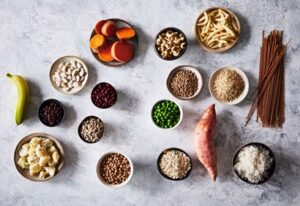RESISTANT STARCH AND DIABETES

As explained in this month’s Food for Thought, resistant starch is the part of starchy foods that resists digestion in the small intestine. Instead, it acts in a similar way to dietary fibre, passing through to the large bowel largely undigested where it provides fuel for gut bacteria. Bacteria in the large bowel ferment and change the resistant starch into short-chain fatty acids, which have several health benefits including protecting against digestive diseases and some types of cancer (e.g., bowel).
There is also evidence that resistant starch may help people with or at risk of diabetes. A 2019 review of 15 clinical trials found that supplementing the diet with resistant starch resulted in lower fasting blood glucose levels, fasting insulin levels and measures of insulin resistance in people with type 2 diabetes and obesity, compared to a control group. However, no effect of resistant starch was seen in people who were overweight but didn’t have diabetes. The researchers found that consuming 30-40g of resistant starch per day decreased fasting blood glucose levels while only 10g per day was enough to lower fasting insulin levels.
Exactly how resistant starch impacts blood glucose and insulin levels is unclear but it may be via effects on gut bacteria. A 2020 review of research into the health benefits of resistant starch on diabetes and obesity via regulation of gut bacteria concluded that resistant starch may modify the gut microbiota (the microorganisms that live in our gut) to produce starch-degrading enzymes, promote the production of beneficial intestinal metabolites like short-chain fatty acids, improving gut barrier function and reducing inflammation. However, further research is needed.
According to Australia’s Commonwealth Scientific and Industrial Research Organisation (CSIRO), the average Australian adult consumes only 3-9g of resistance starch per day, while intakes of 15-20g per day are recommended for gut health.
Resistant starch is found in foods such as wholegrains, legumes (lentils, chickpeas and dried beans), nuts, seeds, starchy vegetables and firm bananas. The way a food is processed, prepared and cooked can affect the amount of resistance starch. For example, cooking and cooling starchy foods increase the resistant starch content, such as cooked and cooled rice, pasta or potato used in salads. Resistant starch may also help lower the glycemic index of some foods.
Read more:
- Liu and colleagues. Health beneficial effects of resistant starch on diabetes and obesity via regulation of gut microbiota: a review. Food Funct. 2020.
- Gao and colleagues. Resistant starch ameliorated insulin resistant in patients of type 2 diabetes with obesity: a systematic review and meta-analysis. Lipids Health Dis. 2019.
- CSIRO. Understanding resistant starch and its role in gut health

Dr Kate Marsh is an is an Advanced Accredited Practising Dietitian, Credentialled Diabetes Educator and health and medical writer with a particular interest in plant-based eating and the dietary management of diabetes and polycystic ovary syndrome (PCOS).
Contact: Via her website www.drkatemarsh.com.au







